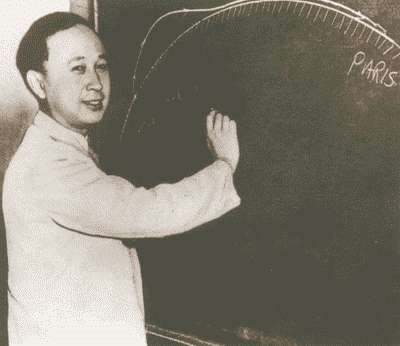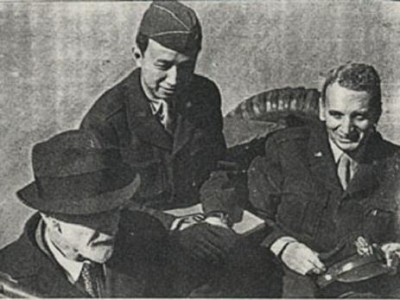| Příjmení: Surname: | Čchien | Qian |
| Jméno: Given Name: | Süe-sen | Xuesen |
| Jméno v originále: Original Name: | 钱学森 | |
| Fotografie či obrázek: Photograph or Picture: | | |
| Hodnost: Rank: | - | - |
| Akademický či vědecký titul: Academic or Scientific Title: | inženýr (MIT 1936) Ph.D. (Caltech 1939) | Master of Science (MIT 1936) Doctorate (Caltech 1939) |
| Šlechtický titul: Hereditary Title: | - | - |
| Datum, místo narození: Date and Place of Birth: | 11.12.1911 Chang-čou | 11.12.1911 Hangzhou |
| Datum, místo úmrtí: Date and Place of Decease: | 31.10.2009 Peking | 31.10.2009 Beijing |
| Nejvýznamnější funkce: (maximálně tři) Most Important Appointments: (up to three) | - | - |
| Jiné významné skutečnosti: (maximálně tři) Other Notable Facts: (up to three) | čínsky raketový vedec a konštruktér | rocket scientist and designer |
| Související články: Related Articles: | | |
| Zdroje: Sources: | http://en.wikipedia.org/wiki/Qian_Xuesen | |
Čchien, Süe-sen
Qian, Xuesen
钱学森
Qian Xuesen (Tsien Hsue-Shen, English transcription: Qian Xuesen; pinyin: Qián Xuésēn; Wade-Giles: Ch'ien Hsüeh-sên), Chinese rocket scientist and designer, a key figure in China's ballistic and space rocket development program.
He was born on 11 December 1911 in Hangzhou, about 180 km south-west of Shanghai. His father later became Minister of Education in Beijing.
In 1934, Qian graduated from Shanghai University with a degree in mechanical engineering. In 1935, he moved to the USA to study at the Massachusetts Institute of Technology (MIT) and later at the California Institute of Technology (Caltech) under Theodor von Kármán.
In the 1940s, Chien is one of the co-founders of the Jet Propulsion Laboratory at "Caltech" and becomes one of the leading figures in high-speed rocket propulsion and aerodynamics research in the USA.
He participated in the development of the first US Privata A and WAC Corporal ballistic missiles and was a member of the "Project Lusty" group dedicated to the search for German aerial rocket technology at the end of World War II.
Upon his return from Germany, Chien edited the results of Project Lusty in an 800-page publication, "Jet Propulsion," which became for many years in the U.S. a literal technical bible in the field of aircraft and missile design.
In the immediate post-war years he visited China, where in 1947 he married the daughter of one of Chiang Kai-shek's military advisors. Shortly after returning to the U.S. in 1949, he obtained U.S. citizenship and became director of JPL.
In 1949, among other things, he designed the supersonic space shuttle, which would later evolve into the X-20 DynaSoar project and then the Space Shuttle.
Shortly thereafter, in 1950, he is falsely accused of being a communist and loses his security clearance. His career in the US is ruined and he decides to return to China. He is subsequently held under virtual house arrest by the US government at the Terminal Island naval base.
Dan A. Kimball had this to say: "It was the stupidest thing this country has done. He (Chien) is no more of a communist than I am - and we drove him out."
Chien's fate was the subject of secret diplomacy between the U.S. and China for five years, until he was exchanged in 1955 for 12 American airmen shot down in the Korean War.
Immediately upon his arrival in China, he embarked on painstaking organizational and training activities. In an agrarian country devastated by war and civil war, he organizes the building of metallurgical, mechanical and electrical industries, research and training of personnel for the needs of the aircraft and missile industries.
In 1956, he puts forward a project to develop the Dongfeng ballistic missile, in 1960 he builds a Chinese copy of the Soviet R-2 rocket (derived from the German V-2), and in 1964 the Dongfeng medium-range rocket project is successfully completed.
In 1967, at the height of the Cultural Revolution, an attempt is made to remove Qian; he is dismissed from his post as head of the "Seventh Ministry of Engineering", but thanks to his merits and the protection of the leadership, he is appointed "Vice-Minister" the next day.
In 1968, Chien organizes the establishment of the Institute of Space Medicine in preparation for manned spaceflight.
In 1970, China's first satellite is successfully launched by a DF-2 rocket. Since 1974, Chinese photo reconnaissance satellites have used reentry cases almost sufficient in size for manned flight.
In the late 1970s, Qian puts forward a project for a manned shuttle launched by a CZ-2 rocket with two launching blocks, not dissimilar to the X-20 DynaSoar project of 15 years earlier.
Qian is also a leading figure in other Chinese rocket programmes and has been instrumental in modernising China's higher education and research system.
In the 1980s, Qian also promoted scientific research on traditional Chinese medicine, qigong exercises, and "unknown/special functions of the human body." He was apparently not interested in research directly, but rather in gathering reliable observations for the purpose of developing a scientific theory.
He retired in 1991 and lived in a sheltered residential area in Beijing.
In 2008, Chinese television listed him as one of the eleven most inspiring people in China.
He died in Beijing on 31 October 2009, aged 98.
Qian Xue-sen's importance to China's aerospace, missile and space programmes is greater than that of figures such as Sergei Korolyov to the Soviet missile and space programme or Wernher von Braun to the US space programme.
sources
Zleva doprava: Ludwig Prandtl (německý vědec), Čchien Süe-sen, Theodore von Kármán. Prandtl sloužil Německu během druhé světové války, von Kármán a Čchien sloužili Spojeným státům, po roce 1955 Čchien sloužil pevninské Číně. Na Čchienově zámořské čepici je uvedena jeho dočasná hodnost plukovníka americké armády. Prandtl byl von Kármánovým doktorandským poradcem; von Kármán zase Čchienův.
commons.wikimedia.org
He was born on 11 December 1911 in Hangzhou, about 180 km south-west of Shanghai. His father later became Minister of Education in Beijing.
In 1934, Qian graduated from Shanghai University with a degree in mechanical engineering. In 1935, he moved to the USA to study at the Massachusetts Institute of Technology (MIT) and later at the California Institute of Technology (Caltech) under Theodor von Kármán.
In the 1940s, Chien is one of the co-founders of the Jet Propulsion Laboratory at "Caltech" and becomes one of the leading figures in high-speed rocket propulsion and aerodynamics research in the USA.
He participated in the development of the first US Privata A and WAC Corporal ballistic missiles and was a member of the "Project Lusty" group dedicated to the search for German aerial rocket technology at the end of World War II.
Upon his return from Germany, Chien edited the results of Project Lusty in an 800-page publication, "Jet Propulsion," which became for many years in the U.S. a literal technical bible in the field of aircraft and missile design.
In the immediate post-war years he visited China, where in 1947 he married the daughter of one of Chiang Kai-shek's military advisors. Shortly after returning to the U.S. in 1949, he obtained U.S. citizenship and became director of JPL.
In 1949, among other things, he designed the supersonic space shuttle, which would later evolve into the X-20 DynaSoar project and then the Space Shuttle.
Shortly thereafter, in 1950, he is falsely accused of being a communist and loses his security clearance. His career in the US is ruined and he decides to return to China. He is subsequently held under virtual house arrest by the US government at the Terminal Island naval base.
Dan A. Kimball had this to say: "It was the stupidest thing this country has done. He (Chien) is no more of a communist than I am - and we drove him out."
Chien's fate was the subject of secret diplomacy between the U.S. and China for five years, until he was exchanged in 1955 for 12 American airmen shot down in the Korean War.
Immediately upon his arrival in China, he embarked on painstaking organizational and training activities. In an agrarian country devastated by war and civil war, he organizes the building of metallurgical, mechanical and electrical industries, research and training of personnel for the needs of the aircraft and missile industries.
In 1956, he puts forward a project to develop the Dongfeng ballistic missile, in 1960 he builds a Chinese copy of the Soviet R-2 rocket (derived from the German V-2), and in 1964 the Dongfeng medium-range rocket project is successfully completed.
In 1967, at the height of the Cultural Revolution, an attempt is made to remove Qian; he is dismissed from his post as head of the "Seventh Ministry of Engineering", but thanks to his merits and the protection of the leadership, he is appointed "Vice-Minister" the next day.
In 1968, Chien organizes the establishment of the Institute of Space Medicine in preparation for manned spaceflight.
In 1970, China's first satellite is successfully launched by a DF-2 rocket. Since 1974, Chinese photo reconnaissance satellites have used reentry cases almost sufficient in size for manned flight.
In the late 1970s, Qian puts forward a project for a manned shuttle launched by a CZ-2 rocket with two launching blocks, not dissimilar to the X-20 DynaSoar project of 15 years earlier.
Qian is also a leading figure in other Chinese rocket programmes and has been instrumental in modernising China's higher education and research system.
In the 1980s, Qian also promoted scientific research on traditional Chinese medicine, qigong exercises, and "unknown/special functions of the human body." He was apparently not interested in research directly, but rather in gathering reliable observations for the purpose of developing a scientific theory.
He retired in 1991 and lived in a sheltered residential area in Beijing.
In 2008, Chinese television listed him as one of the eleven most inspiring people in China.
He died in Beijing on 31 October 2009, aged 98.
Qian Xue-sen's importance to China's aerospace, missile and space programmes is greater than that of figures such as Sergei Korolyov to the Soviet missile and space programme or Wernher von Braun to the US space programme.
sources
http://www.astronautix.com/astros/tsien.htm
http://en.wikipedia.org/wiki/Qian_Xuesen
Zleva doprava: Ludwig Prandtl (německý vědec), Čchien Süe-sen, Theodore von Kármán. Prandtl sloužil Německu během druhé světové války, von Kármán a Čchien sloužili Spojeným státům, po roce 1955 Čchien sloužil pevninské Číně. Na Čchienově zámořské čepici je uvedena jeho dočasná hodnost plukovníka americké armády. Prandtl byl von Kármánovým doktorandským poradcem; von Kármán zase Čchienův.
commons.wikimedia.org
Reklama
Join us
We believe that there are people with different interests and experiences who could contribute their knowledge and ideas. If you love military history and have experience in historical research, writing articles, editing text, moderating, creating images, graphics or videos, or simply have a desire to contribute to our unique system, you can join us and help us create content that will be interesting and beneficial to other readers.
Find out more
